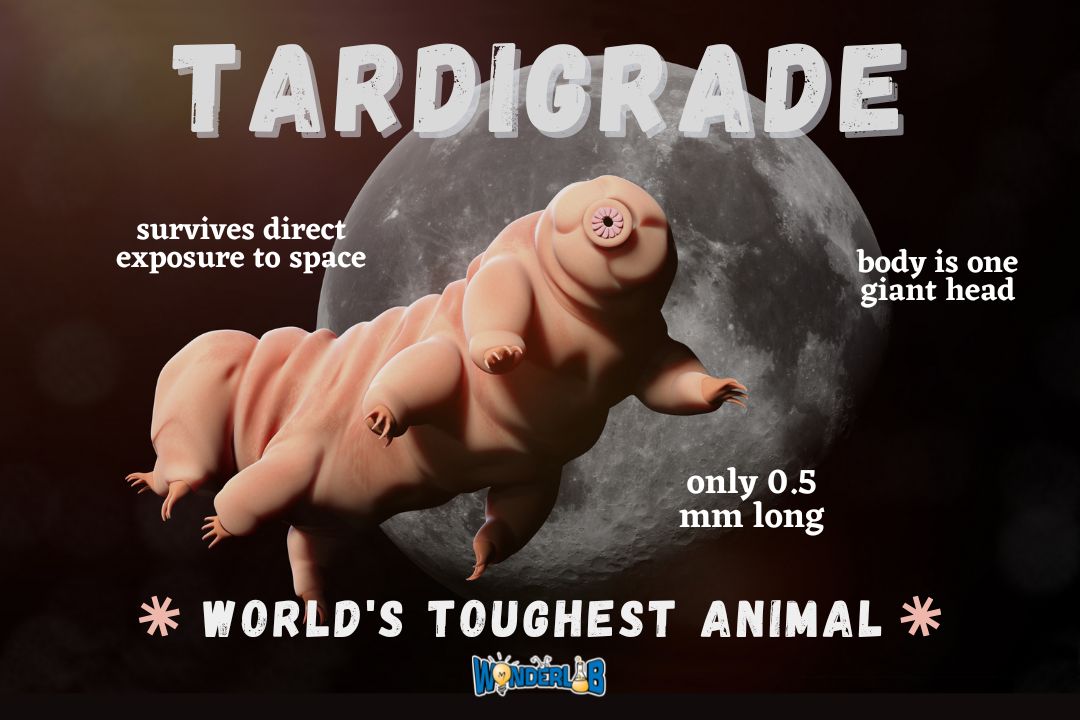
Image credit: WonderLab Staff
Tardigrades are microscopic aquatic animals also known as water bears or moss piglets.
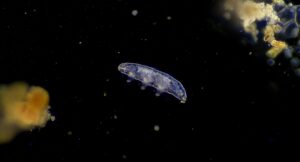
Image Source: Canva
There are around 1,300 species of water bears around the world. The species range in size from 0.05mm – 1.2mm in body length. For reference, the average grain of salt is only 0.3mm!
Tardigrades are considered aquatic because they need a layer of water around them to survive. The water that surrounds the tardigrade allows gas exchange to occur and prevents them from becoming dangerously dehydrated (though they can still survive if they do… read about the anhydrobiosis process below!). Although they are considered aquatic, they can be found in many different environments from sand dunes to the deep sea. They prefer living in freshwater mosses and lichens.
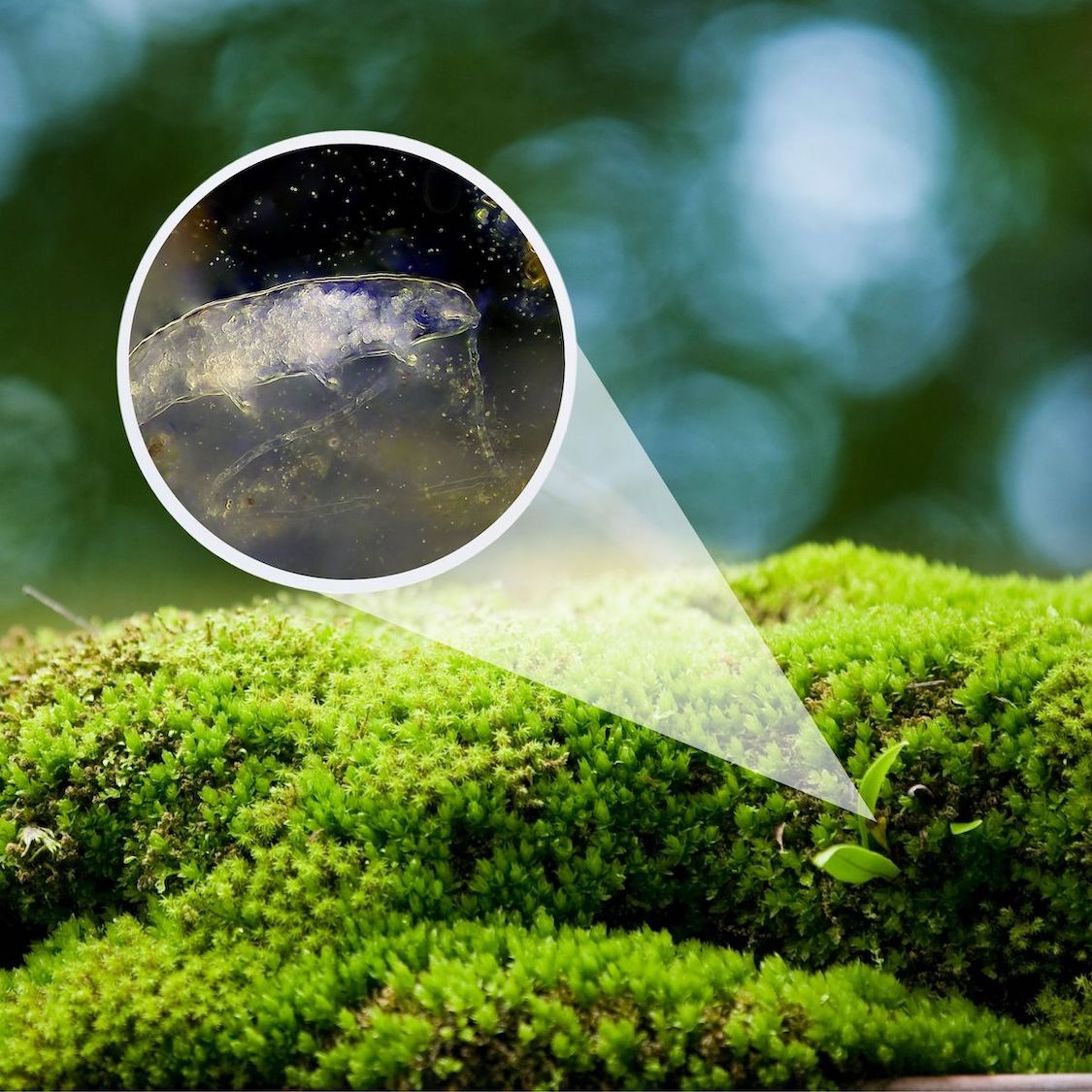
Image source: Canva
Though the little bears look soft and squishy, they’re actually covered in tough exoskeletons that shed when they grow– just like grasshoppers and praying mantises.
When tardigrades shed, they also shed their teeth. These sharp styletets in the mouth allow tardigrades to pierce cells of plants and other invertebrates. After the molting process, the tardigrades secrete new teeth through a pair of glands in their mouth.
The sharp styletets are part of the bucco pharyngeal apparatus, a piercing-sucking mouthpart, which tardigrades use to eat plant cells and some small animals.
One Giant Head
Wait what?? Yes, the cute bear with eight legs… might be a walking head.
Let’s break it down.
“Hox genes” are bits of DNA that determine how the body is organized. Mutations in Hox genes can cause problems like legs growing out of the head (starting to see where this is going?).
In order to theorize on the tardigrade’s unique anatomy, researchers compared their Hox genes with that of those found in arthropods, cousins to the tardigrade. They realized that tardigrades are missing thge Hox genes that arthropods have. Researchers discovered that as tardigrades evolved from their shared ancestor with arthropods, four or five Hox genes disappeared, but only in tardigrades. With the disappearance of these genes, researchers believe sections of the tardigrade ancestor’s midsection disappeared. Eventually, just the head was left.
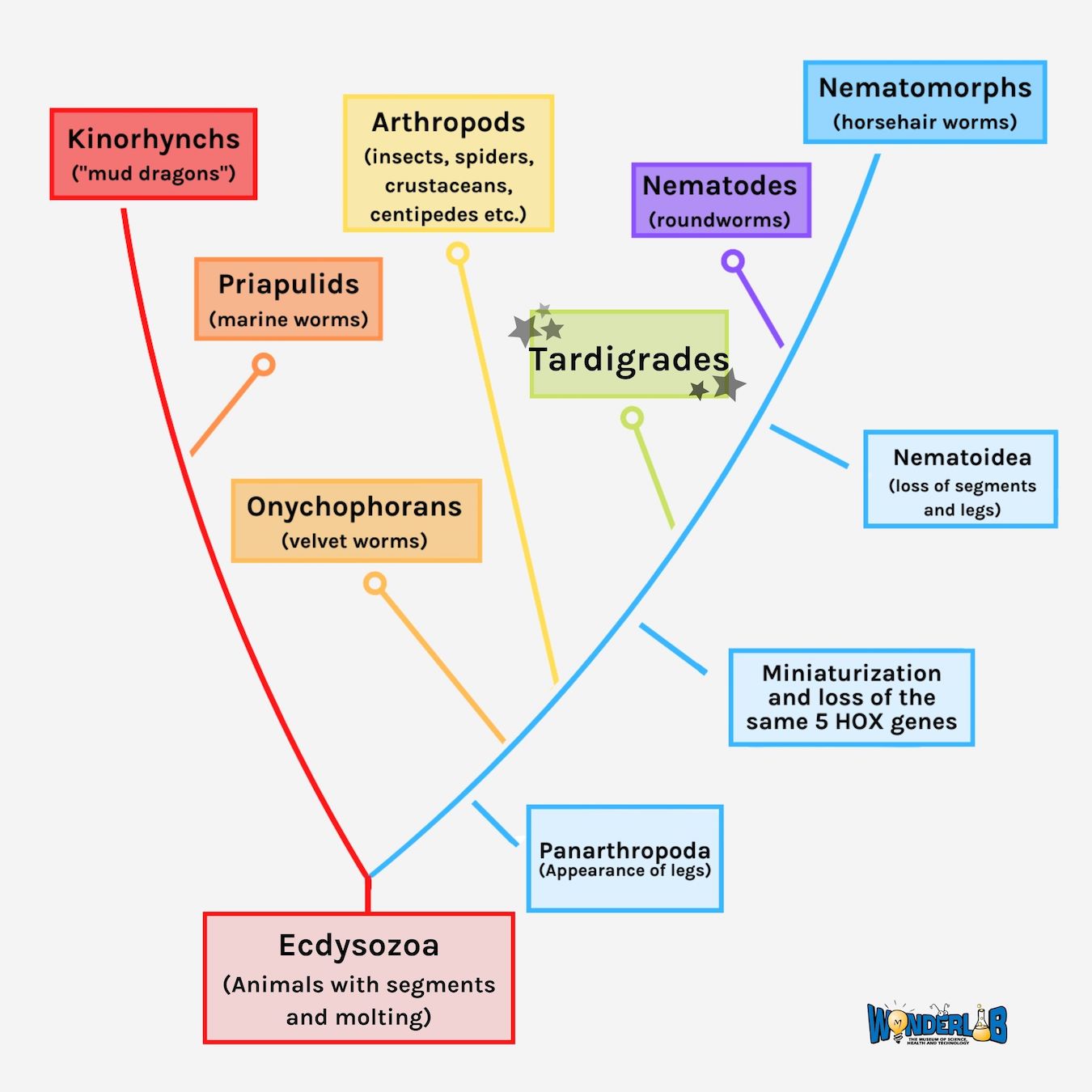
Image credit: WonderLab Staff
Survives Direct Exposure to Space
In 2007, a research team sent 3,000 tardigrades to space for 12 days… outside of a rocket… and 68% of them survived!
It’s not just outer space that tardigrades can withstand. They are practically indestructible, surviving at temperatures as cold as absolute zero, in heat beyond the boiling point, and can withstand pressures six times that of the ocean’s deepest trench.
How do these little creatures survive so many extremes?
The tardigrade super power is a process called cryptobiosis which allows tardigrades to survive extreme environmental stressors. When in this state, metabolic function stops. It’s a lot like an extreme state of hibernation that much bigger black and brown bears experience every winter.
There are many types of cryptobiosis, but the most common type found in tardigrades is anhydrobiosis, a process in which the animal loses virtually all water from its body, but is still able to survive and continue normal function when it becomes rehydrated. So a water bear can dry up, survive for years without water, and be completely revived when they come in contact with water.
During the dehydration process, tardigrades curl into a compact shape. While much is still unknown about the anhydrobiosis process, there is wide support for the so-called vitrification hypothesis. This hypothesis proposes that specific proteins are produced in reaction to environmental stressors which fill up cells and form a protective matrix.
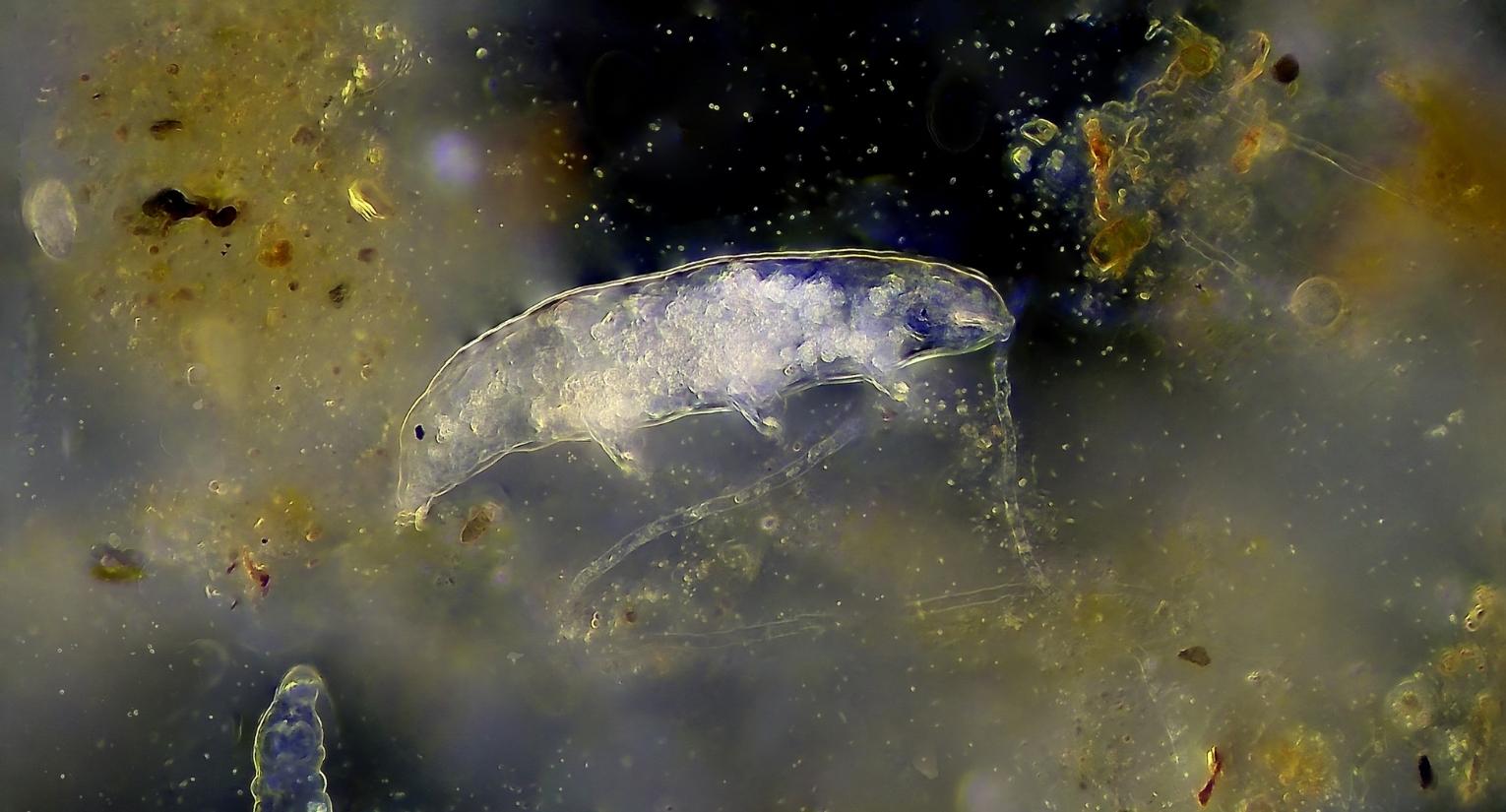
Image source: Canva
Researchers have discovered that the special proteins that contribute to tardigrades’ survival can function in other organisms. This means tardigrade proteins may be able to help preserve other biological materials like cells, tissues, or even vaccines! That means that life-saving materials would stay usable longer– and potentially save more human lives.
 About the Author: Sam Ryan is a Development Intern at WonderLab. She grew up in central Missouri chasing roly-polies, running from mosquitos, and learning about conservation from her wildlife biologist dad. She’s new to water bears, but as a fan of manatees she deeply appreciates that tardigrades look a lot like manatees in hazmat suits. Like the majestic manatee, she spends much of her time eating and resting.
About the Author: Sam Ryan is a Development Intern at WonderLab. She grew up in central Missouri chasing roly-polies, running from mosquitos, and learning about conservation from her wildlife biologist dad. She’s new to water bears, but as a fan of manatees she deeply appreciates that tardigrades look a lot like manatees in hazmat suits. Like the majestic manatee, she spends much of her time eating and resting.
Sources:
- https://www.science.org/content/article/hardy-water-bears-survive-bullet-impacts-point
- (n.d.) Tardigrade. National Geographic. Retrieved May 19, 2022, from https://www.nationalgeographic.com/animals/invertebrates/facts/tardigrades-water-bears?loggedin=true.
- Bordenstein, S. (n.d.). Tardigrades (Water Bears). Science Education Resource Center at Carleton College. Retrieved May 19, 2022, from https://serc.carleton.edu/microbelife/topics/tardigrade/index.html.
- Convey, P. (2013). Antarctic Ecosystems. Encyclopedia of Biodiversity (Second Edition). Retrieved May 19, 2022 from https://www.sciencedirect.com/topics/biochemistry-genetics-and-molecular-biology/anhydrobiosis#:~:text=with%20human%20activity.-,Anhydrobiosis,Cryoturbation.
- (n.d.). Experiment with the Tardigrade: The Phenomenon of Cryptobiosis. University of Washington. Retrieved May 23, 2022 from http://faculty.washington.edu/jdwest/infodesign/tables/text-0.htm.
- Imster, E. (2021, June 10). Why NASA sent tiny water bears into space. EarthSky. Retrieved May 23, 2022 from https://earthsky.org/space/water-bears-tardigrades-into-space-iss-experiment/.
- Brummer, R., Hengherr, S., Reuner, A., Schill, R. O., & Worland, M.R. (2009, November/December). High‐Temperature Tolerance in Anhydrobiotic Tardigrades Is Limited by Glass Transition. Physiological and Biochemical Zoology, Volume 82, Number 6. Retrieved May 23, 2022 from
- https://www.journals.uchicago.edu/doi/full/10.1086/605954?casa_token=WeqfWj7Dl1IAAAAA%3AV_HKuPQk8kOLajsn31IZIIqjEhkLKwPtLFKAg7GMT49kzCCyjrFjOS-emt1z9_JSEIc1MekjI5mfzw.
- Clark, M. (n.d.) Tardigrades. UCL Young Scientist. Retrieved May 23, 2022 from https://www.ucl.ac.uk/biosciences/home/study/partnerships-and-innovation/outreach-and-public-engagement/projects/ucl-young-bioscientist/tardigrades.

Leave A Comment